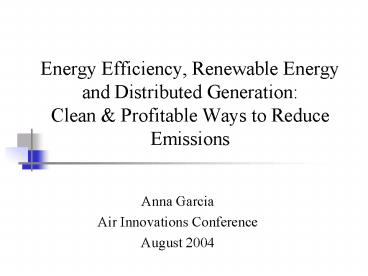Energy Efficiency, Renewable Energy and Distributed Generation: Clean - PowerPoint PPT Presentation
1 / 16
Title:
Energy Efficiency, Renewable Energy and Distributed Generation: Clean
Description:
Saves money, lowers compliance costs, creates jobs and raises productivity ... One NJ program: $200M to ratepayers over 5 years. Increased local employment ... – PowerPoint PPT presentation
Number of Views:38
Avg rating:3.0/5.0
Title: Energy Efficiency, Renewable Energy and Distributed Generation: Clean
1
Energy Efficiency, Renewable Energy and
Distributed GenerationClean Profitable Ways
to Reduce Emissions
- Anna Garcia
- Air Innovations Conference
- August 2004
2
Overview
- Energy efficiency is fastest, most cost effective
remedy to satisfy both power needs and
environmental quality concerns - Renewable energy and clean distributed generation
provide cleaner energy that reduce stresses on
the electricity grid. - States, cities and businesses are using these
technologies to save money and improve the
environment and their local economies through
innovative partnerships and strategies
3
Why EE and RE Makes Sense
- Improves the Environment
- Reduces multiple emissions (NOx, SO2, CO2, Pb,
Hg) by up to 100 for displaced generation at
lower cost - Boosts the Local Economy
- Saves money, lowers compliance costs, creates
jobs and raises productivity - Efficiency turns over an average 7X in local
economy - Enhances Electricity Reliability
- Lowers electricity demand and relieves
transmission load in constrained markets
4
EE Offers Critical Environmental Benefits
- Energy Innovations, 1997 Innovations Path
reduces energy consumption by over 40, and by
2010 reduces the following pollutants - NOx to 24 below 1990 levels
- SO2 to 64 below 1990 levels
- CO2 to 10 below 1990 levels
- Clean Energy Futures, 2000 Efficiency programs
reduce demand growth by 20 to 47 - avoid need for 250 - 600 big 300 MW power plants
and their associated emissions
5
EE Reduces Emissions Cost-Effectively
Source Analyzing Electric Power Generation Under
the Clean Air Act, US EPA, March 1998
6
Source STAPPA/ALAPCO, 1999.
7
Source The Center for Applied Research, 1997.
8
GHG Emissions Increasing 60 Percent by 2025
Projected U.S. carbon emissions by sector and
fuel, 1990-2025 (million metric tons)
Energy Information Administration, Annual Energy
Outlook 2004 with Projections to 2025, January
2004
9
Energy Efficiency Helps Economic Development
- Conventional power supply 4 - 10 cents/kWh
- Energy Efficiency lt1.5 - 2 cents/kWh
- Energy efficiency can reduce base loads and peak
demands, enhancing system security - Energy efficiency increases reliability and
supply - If we help our businesses reduce the cost of
operation, our products can be more competitive,
and we can create more jobs - If we install energy improvements and renewable
energy applications we create good new jobs
10
Economic Benefits of EE
- Savings for facility owners, consumers
- One NJ program 200M to ratepayers over 5 years
- Increased local employment
- Construction, engineering and maintenance
- Full-time, long-lasting jobs
- Avoided cost of additional TD, upgrades
- Avoided cost of power or generation, and
elimination of line losses
11
Reliability Benefits of EE
- Deliver new resources faster than generation,
transmission, pipelines, wells - Support weak points on grid
- Capacity
- Energy
- CA re-targeting EE programs to reduce peak
- 14 of peak is residential use
- another 14 is commercial use
12
Electricity reliability transmission
Electricity Generation by Fuel, 1970-2025
(billion kwh)
Energy Information Administration, Annual Energy
Outlook 2004 with Projections to 2025, January
2004
13
By 2011, generating capacity anticipated to
increase 30...
compared to a 5 increase in transmission
14
- Aspects of air quality planning processes that
are disincentives to energy efficiency - Input-based limits and budgets rather than
output-based - Focus on end-of-pipe, single pollutant fixes
- No economic value attributed to prevention of
multiple pollutant emissions achieved through
efficiency
15
Why It Makes Sense
- Improves Air Quality
- Reduces air pollution more effectively than many
end-of-pipe controls - Prevents emissions of NOx, SO2, PM, CO2, and Hg
- Accelerated adoption of EE/RE technologies can
improve a state/local areas air quality - Emissions reductions are cost-effective
- Improves the Economy
- Saves money by reducing energy use and bills, and
lowering compliance costs - Creates jobs and increases productivity,
resulting in higher Gross State Product - Greater economic growth more in states
budget - Increases comfort productivity
16
Whats going on in the states?
R
R
Regional GHG Initiative (RGGI) not including MD
and Regional GHG Registry (RGGR)
R
R
R
R
R
Climate Action Plans
Net Metering
Public Benefit Funds
Renewable Energy Mandates
West Coast Governors Initiative
Completed GHG inventory
Mandatory Reporting or Voluntary Registries for
GHG
R
GHG inventory in progress
Note Data from Pew Center, www.pewclimate.org/wh
at_s_being_done/in_the_states

